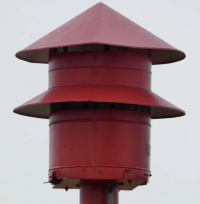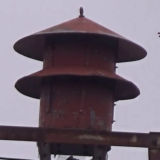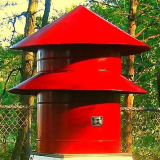Sireno vertical sirens
Sireno ½ hp siren
Sireno 3 hp siren
Sireno 5 hp siren
| |

| |
| Company | Sireno |
|---|---|
| Type | Omnidirectional Electromechanical |
| Frequency | 50/60 Hz |
| Horsepower | ½-5 hp |
| Voltage | 220/440 V 3 ph |
For an unknown period of time, Sireno produced vertical ½-5 hp sirens (commonly referred to as the Type 3 and Type 5, though there is no evidence to support these names and are likely misnomers), none of which have known model names as little documentation regarding them is known to exist. Their designs were actually made by Harry O. Ricci, who sold some of his patents to Sireno. Little is known about these sirens, and very few are known to exist, though many have been confused with weatherproof Siro-Drones and vice versa.
Note: Due to the lack of known model names, these sirens have been given conjectural names.
Design
½ hp
Sireno is known to also have produced a ½ hp model, although none of these are known to exist, presumably because of their lackluster performance compared to its competitors. It's unknown what exactly these ½ hp sirens looked like, though they may have been similar in appearance to a Model 2, which this siren may have been intended to compete with. Little else is known about the siren.
3 hp

The 3 hp model utilizes a 10-port rotor and stator (the designs of which come from H.O.R.) and a 3 hp motor located below the stator. The siren rests upon a square base with 4 holes in each corner, allowing for the siren to be bolted to a flat surface. The siren uses a cylindrical housing has a design similar to Federal's Model 5 series, specifically the Model 3 (which the siren was likely intended to compete with), featuring a single, small skirt helping to project the sound downwards and outwards from the rotor. There are 4 openings underneath the skirt with a mesh screen that exposes the rotor and stator, as well as 4 openings above the skirt where the intake pulls air. These openings are divided by brackets which run nearly the entire length of the siren's housing. Air is drawn into the siren's rotor, as they lack a proper intake, through the upper and lower openings on the housing. This is topped with a rain shield, which is typically larger in diameter compared to the skirt, though on some units they are of equal length. Most 3 hp model units have eyebolts on top of the rain shield. Some 3 hp units have 5 hp housings, making identifying them difficult. These sirens are often confused with Federals, though can be differentiated via their shorter, thinner proportions, flatter skirts, and port ratio.
5 hp

The 5 hp model, which is the most common, utilizes a 10-port rotor and stator (the designs of which come from H.O.R.) and a 5 hp motor located below the stator. The siren rests upon a square base with 4 holes in each corner, allowing for the siren to be bolted to a flat surface. The siren uses a cylindrical housing has a design similar to Federal's Model 5 series (which the siren was likely intended to compete with), featuring a single, small skirt helping to project the sound downwards and outwards from the rotor. There are 4 openings underneath the skirt with a mesh screen that exposes the rotor and stator, as well as 4 openings above the skirt where the intake pulls air. The 5 hp model lacks the dividing brackets present on the 3 hp one. Air is drawn into the siren's rotor, as they lack a proper intake, through the upper and lower openings on the housing. This is topped with a rain shield, which is equal in diameter compared to the skirt, unlike most 3 hp units' housings. There are 3 ph units which have the same housing, making identifying them difficult. Some 5 hp units also have housings which are significantly taller than average compared to others. No 5 hp units are known to have eyebolts on top of their rain shield. These sirens are often confused with Federals, though can be differentiated via their shorter, wider proportions, flatter skirts, and port ratio.